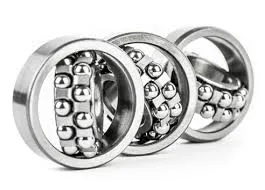
Dec . 15, 2024 08:00 Back to list
what is cylindrical roller bearing
Understanding Cylindrical Roller Bearings
Cylindrical roller bearings are a vital component in the world of mechanical engineering and machinery. They are designed to handle radial and axial loads, making them essential in various applications ranging from automotive to aerospace. This article delves into the structure, function, advantages, and applications of cylindrical roller bearings.
Structure of Cylindrical Roller Bearings
Cylindrical roller bearings consist of an inner ring, an outer ring, rolling elements in the form of cylindrical rollers, and a cage that holds the rollers in place and aids in their motion. The shape of the rollers, which are elongated and cylindrical, allows for a larger contact area with the raceways of the inner and outer rings. This design helps distribute the load evenly across the bearing, minimizing stress and wear.
The rollers in cylindrical roller bearings are often arranged in a single row, but they can also be found in multiple rows depending on the bearing's design and load requirements. Common configurations include single-row, double-row, and four-row designs. Each type is tailored to meet specific requirements, such as increased load capacity or enhanced stability.
Function of Cylindrical Roller Bearings
The primary function of cylindrical roller bearings is to facilitate rotational movement while reducing friction. As an essential survival mechanism in rotary equipment, these bearings support the shafts and allow them to rotate smoothly. The cylindrical shape of the rollers enables them to handle higher loads compared to ball bearings, making them suitable for heavy-duty applications.
Cylindrical roller bearings are particularly adept at managing radial loads, which are forces exerted perpendicularly to the shaft. They can also accommodate some axial loads, depending on the design and configuration. This makes them versatile for various applications, ensuring that they can withstand both stationary and dynamic conditions.
Advantages of Cylindrical Roller Bearings
what is cylindrical roller bearing

Cylindrical roller bearings offer several advantages over other types of bearings. Firstly, their ability to handle high radial loads is unmatched, allowing them to function effectively in heavy machinery. The larger contact area of the cylindrical rollers reduces stress concentration, thereby prolonging the life of the bearing.
Additionally, cylindrical roller bearings have a high rigidity, which is critical in applications requiring precision and stability
. The design reduces friction between the moving parts, which minimizes heat generation and energy loss, making the overall system more efficient.Another significant advantage is their ease of assembly and disassembly. Many cylindrical roller bearings are designed with separable inner and outer rings, facilitating more straightforward installation or replacement. This is particularly beneficial in maintenance-heavy industries where downtime can be costly.
Applications of Cylindrical Roller Bearings
Cylindrical roller bearings are widely used across various industries. In the automotive industry, they can be found in gearboxes, wheel hubs, and engine components. Their ability to accommodate misalignment and high radial loads makes them ideal for these applications.
In the manufacturing sector, machines such as lathes, milling machines, and conveyors often utilize cylindrical roller bearings due to their reliability and performance under heavy loads. Similarly, in the aerospace sector, these bearings are employed in engine mounts, landing gear, and other critical components where safety and performance are paramount.
Furthermore, cylindrical roller bearings are commonly used in electric motors, pumps, and compressors. They facilitate smooth operational efficiency and reliability, crucial for equipment in continuous operation.
Conclusion
Cylindrical roller bearings play an integral role in ensuring the reliability and efficiency of modern machinery. Their robust design, capacity to handle heavy loads, and versatility make them indispensable across a variety of industries. Understanding their structure, function, and applications is essential for engineers and technicians aiming to optimize machinery performance. As technology advances, the development of new materials and designs promises to enhance the capabilities of these bearings even further, ensuring they remain at the forefront of engineering innovation.
Latest news
-
Premium Deep Groove Ball Bearings | High Speed & Reliability
NewsAug.29,2025
-
Durable Scaffolding Clamps - Secure & Reliable Tube Connectors
NewsAug.28,2025
-
Common Failures in Thrust Ball Bearings and Solutions
NewsAug.22,2025
-
How Tapered Roller Bearings Can Take Shock Loads
NewsAug.22,2025
-
Angular Bearings in High-Precision Spindles
NewsAug.22,2025
-
The Impact of Misalignment on Cylindrical Roller Bearing Performance
NewsAug.22,2025
